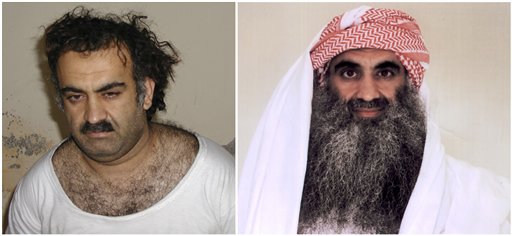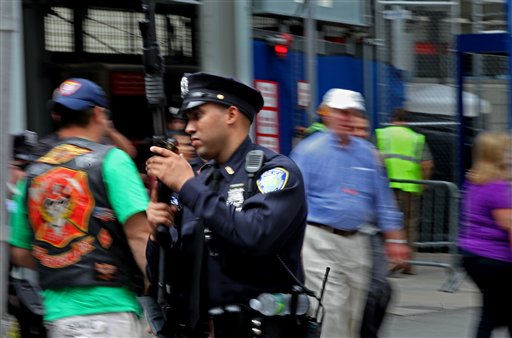Mevorach thinks it is not at all hyperbolic to compare Fleischer’s reaction to the Tower’s collapse with other famous radio reactions, notably the Hindenburg’s fiery end in May 1937. As Herb Morrison reported the arrival of the massive zeppelin for WTS radio in Chicago, the craft burst into flames, resulting in Morrison’s legendary quote, “Oh, the humanity.”

The current construction at the World Trade Center site.
“As far as the historical perspective, it’s bigger [than the Hindenburg],” says Mevorach. “There were so few reporters when the Hindenburg crashed, but on Sept. 11 there were thousands of reporters reacting. Joan’s account was real, it was more powerful, and it stood out.”
Harris agrees.
“In a way, we almost got better coverage by going with a non-professional on the air because she went with her pure gut reaction to it, whereas professionals are trained not to do that, and I think most of them wound up screaming anyway, but she had no compunction about it,” says Harris.
Fleischer tried to describe what she saw, but she says she had no control over her reaction.
“What else could you say, but, ‘Oh my God, the Tower went down’?” says Mevorach.
Montone did not hear the call, of course. Instead, he suddenly faced what he calls a “tsunami without water,” as the ungodly clouds of dust, smoke and ash began to rush through the streets as the building fell in upon itself.
“You felt it, and there was some panic,” says Montone. “Little bunches of people were diving into buildings on Broadway, and I got kind of carried with some of them.”
Montone wound up in the darkened hallway of a building. The dust was piling up. He began to feel the crush of people as they came from another direction, from Nassau Street, and he got scared that this might be it. He pushed to get out, stepped into the street and was met by a massive dust cloud. He had other concerns, too.
“My first thought was, ‘I lost my fucking tape recorder,’’’ says Montone. The one tool he needed to do his job and document the attacks was gone. He still had his microphone, clutched tightly in his hand.
“I was sick, as [any reporter] would be,” says Montone. “But then I observed again.”
That’s when he saw the blank faces of survivors walking in the street. The ash was thick on their bodies.
Harris says that later, WINS Wall Street reporter Larry Kofsky returned to the newsroom still clad in the ash-covered suit he was wearing when he fled lower Manhattan. In the crush of people, he had been knocked down.
“In the middle of his back was a footprint,” says Harris.
He had a lot to keep track of now. The newsroom buzzed as the staff scrambled to gather information. They also knew that Montone was in the shadow of the Tower when it had fallen, but nobody knew his fate. Throughout his time on the air, Harris would provide quick recaps, offering lines like, “If you are just waking up and joining us this morning…,” before recounting the nightmare.
Meanwhile, Montone choked and gasped for air. He stumbled into a Burger King and asked them if they had a phone. He wasn’t done reporting. But a woman at the restaurant told him to not think about the phone. She got water and began to pour it on his face. Montone threw up the dust that was clogging his throat. He was alive, but he was still a reporter. He wanted to get back on the air and tell the people what he had just lived through.
“A banana unpeeling”
By this time, Mevorach had found his way to Brooklyn, near the Manhattan Bridge. Somehow, inexplicably, he was able to get a cell signal and call the station. He interviewed the people who were walking catatonically across the bridge, covered in thick, white ash. As he walked over the bridge into lower Manhattan, he spoke on air to DeAngelis, who had taken over the anchor chair from Harris.
DeAngelis is a 21-year veteran of the station. She speaks slowly and clearly, with lovely diction and a calming, soothing voice. She seems serious, but cracks a good joke. For hours she had helped out in the newsroom as Harris ran the anchor chair. She, too, wanted to get on air and weigh in on this monumental disaster. She would get her shot about 10 minutes later.
Mevorach was on the air with DeAngelis, describing the ghostly parade of survivors when it happened.
“Something is—I can’t—it looks as if the building is going—is that the building going down? Is that the second building of the World Trade Center going down?” he asked into the phone.
“Yes, that is second—that is the second tower!” answered DeAngelis.
Mevorach was at a loss for words. He tried, but eventually just said that words could not describe it. And then DeAngelis said something that perplexed Mevorach.
“It came out like a plume of smoke, like a banana unpeeling,” she said.
“I thought that was the strangest thing to say when I heard it,” says Mevorach. “I could not imagine why she used that analogy.”
But from her vantage point in the studio, the collapsing tower did indeed look like a huge banana as it began to implode, each of its four sides separating and creating a separate column of ash. When Mevorach later saw the video, he understood.
Fleischer also saw the second tower fall. By that time, her nerves were completely frayed. She had little left to give to 1010 WINS in the way of Sept. 11 coverage. She had seen the terror, and told the story. Mason told her she could hang up not too long after her last report.

1010 WINS Anchor Judy DeAngelis
Mevorach continued toward the scene, and somehow stumbled upon his friend and colleague Montone in his truck on Church Street, trying to drive out of the area.
The two men embraced. And then Montone sat down and began to cry.
“It was a chaotic scene, he pulled over in his car, and I remember looking at his car, which was covered in ash, and I thought, ‘Holy shit,’” says Mevorach. “[Montone] got out of his car, and I guess he had been in reporter mode, but when we saw each other I guess the other mode clicked on and it was very emotional. He sat down on the curb, absorbed everything.”
“New York City Closed”
DeAngelis had to get home to her family. She knew her children were worried about her. She needed to see them, touch them. She decided to take a chance and leave. Go home, her bosses told her, but you’d better be here for your 4 a.m. shift. As the attacks unfolded, one of her children went to a school office and expressed her concern. Since WINS follows such a scripted schedule, DeAngelis’ daughter knew she would be able to hear her mom’s voice at 20 minutes after the hour. Those reports would assure DeAngelis’ daughter that her mom was fine.
“But of course, that was the morning that nothing was fine, and when they turned on the radio and did not hear my voice, my daughter became very frightened,” says DeAngelis.
DeAngelis jumped into a car with an acquaintance of Montone’s, who lives in the same town as she. The man climbed into the car, covered in ash.
“I said to him, ‘You must be really uncomfortable,’” she says. “And he said, ‘You know what makes me really uncomfortable? The fact that I know that most of this is human.’”
As they traveled up the West Side Highway, they were the only car. All along the side were National Guardsmen with rifles. When the car got to the tunnel, a sign told the story.
“All it said that day were four words,” says DeAngelis. “New York City Closed.”
Mitchell Stephens, professor of journalism at the Carter Institute at New York University, says that the media were faced with an unmatched challenge on that day. Stephens co-edited the book Covering Catastrophe: Broadcast Journalists Report 9/11. Some of the stories of 1010 WINS are included in those pages.
“[The event] had a profound effect on especially radio and television journalists,” says Stephens. “It was a peak moment in everybody’s career who covered the story.”
While Stephens does not believe the attacks were a transformative event in media, he does feel that media itself has changed so drastically since then that such a story would probably not be covered the same way again.
For weeks after, while the pile of rubble continued to smolder, New Yorkers listened to the voices of the anchors and reporters at WINS. The station passed on millions of dollars and remained commercial-free for one week. It also broke ratings records. During the first few hours of the attacks, the station registered the first-ever 1 million-listener number in every quarter-hour. It also had the single-highest cumulative number for a radio station ever in the first 24 hours of the attacks.
Turn it on any other day, and you know what you will get. Someone once described 1010 WINS programming to Mevorach as a carousel.
“You go around once, you see everything, maybe even twice, but then you’re done and you move on,” says Mevorach.
Mason has listened to the tapes many times, and he continues to be proud of the work the staff did on Sept.11. He says that the staff’s news experience was obvious, but it was the human spirit that made the 1010 WINS coverage so important.
“Everyone in the newsroom had family members and friends out there. We got calls from people looking for information about companies or people, and we still had to do our jobs. I will never forget the work they did in the newsroom, or the wonderfully compassionate job the reporters and anchors did,” says Mason.
“There is no training for a day like this. There is no book to teach you how to do that. But when you are faced with it, you have to find it.”






